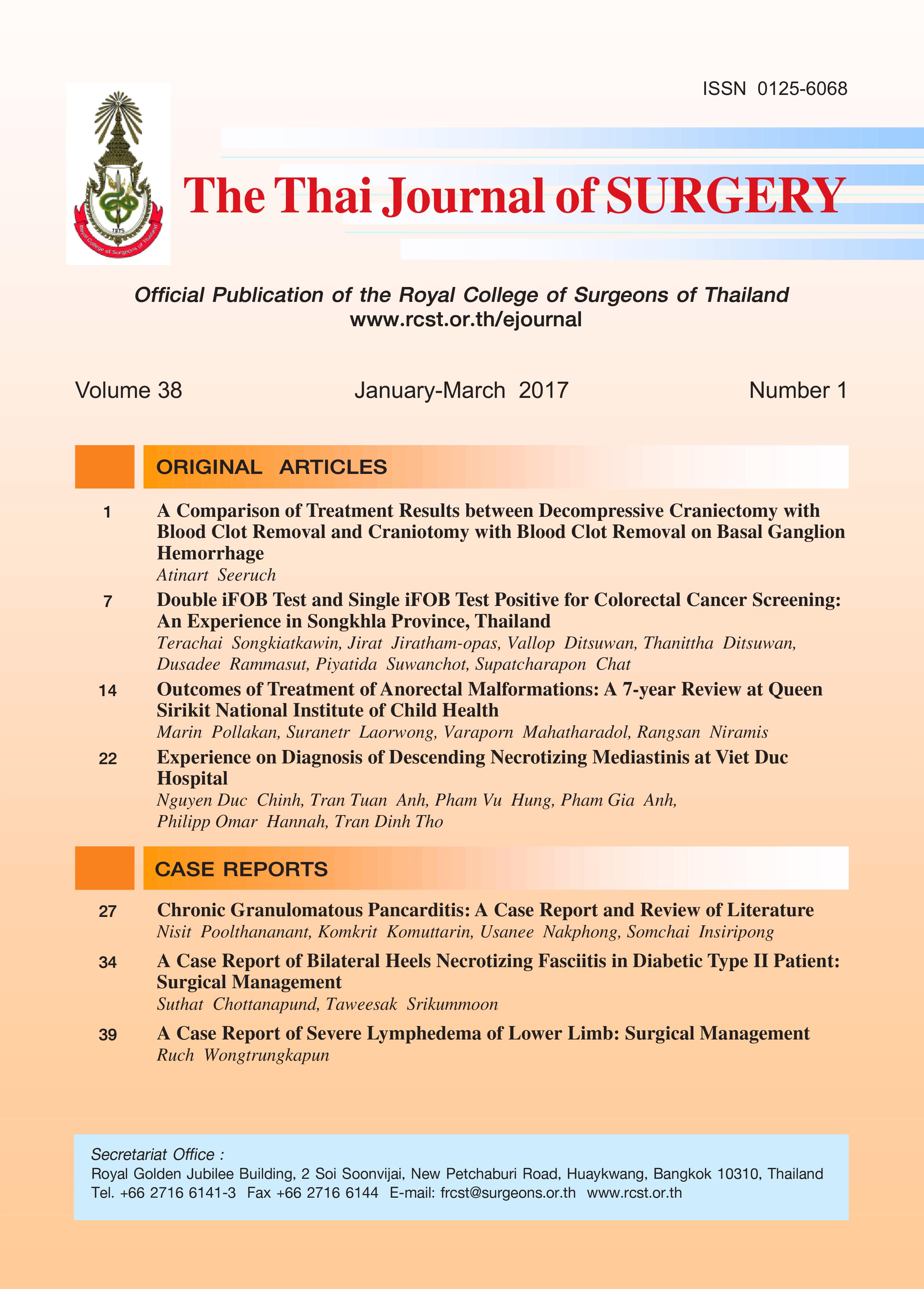A Comparison of Treatment Results between Decompressive Craniectomy with Blood Clot Removal and Craniotomy with Blood Clot Removal on Basal Ganglion Hemorrhage
Keywords:
Decompressive craniectomy with blood clot removal, craniotomy with blood clot removal, basal ganglion hemorrhageAbstract
Background and Objective: Basal ganglion is about 50% of Intracerebral hemorrhage which has high morbidity and mortality. The objective of the present study is to compare the results of treatment on basal ganglion hemorrhage between decompressive craniectomy and blood clot removal with craniotomy and blood clot removal by using the modified ranking scale (mRS) at discharge, 3 months, 6 months and death rate within 30 days.
Methods: A retrospective review of medical records of patients of Lampang Hospital who were diagnosed with basal ganglion hemorrhage and had surgery from 2010 to 2015 was performed. Information of patients includes sex, age, number of patients, Glasgow coma score of < 8 before surgery, midline shift > 0.5 cm. Intraventricular hemorrhage and death within 30 days were collected. Both groups were compared by using Fisher’s Exact Test and student t-test. P-value < 0.05 was considered statistically significant.
Results: Of 256 patients, 117 cases were operated by decompressive craniectomy with clot removal while 139 cases were operated by craniotomy with clot removal. The sex and number of patients of midline shift were not statistically different. The age and number of patients of GCS < 8 before surgery and intraventricular hemorrhage were significantly different. Favorable outcome (MRS <3) of decompressive craniectomy group at discharge was not different from craniotomy group (8.6% vs. 6.5%, p = 0.634). But at 3 months and 6 months were significantly different (34.2% vs. 18.7%, p = 0.006 and 35.9% vs. 19.42%, p = 0.004). Death within 30 days was statistically different (19.7% vs. 34.5%, p = 0.011).
Conclusion: Decompressive craniectomy with blood clot removal is the alternative operation to treat basal ganglion hemorrhage to patients with midline shift of > 0.5 cm. or uncontrollable intracranial pressure due to better favorable outcome and has lower death rate than craniotomy with blood clot removal.
References
2. Chalotte J J van Asct. Incidence, case fatality, and functional outcome of intracerebral haemorrhage over time, according to age, sex, and ethnic origin; a systematic review and meta-analysis. Lancet Neurol 2010;9:167-76.
3. Powers WJ, Derdeyn CP, Biller J, Coffey CS, Hoh BL, Jauch EC et al. on behalf of the American Heart Association Stroke Council. 2015 AHA/ASA Focused Update of the 2013 Guidelines for the Early Management of Patients With Acute Ischemic Stroke Regarding Endovascular Treatment: A Guideline for Healthcare Professionals From the American Heart Association/American Stroke Association. Stroke. [serial on the Internet]. 2015 Jun [cited 2016 May 31]:[about 47 p.]. Available from: https://stroke.ahajournals.org/
content/early/2015/06/26/STR.0000000000000074.full.pdf
4. Tao Xu, Treatment efficacy of the transsylvian approach versus the transtemporal cortex approach to evacuate basal ganglia hematomaUnder a microscope. J Craniofacial Surg 2016;27:308-12.
5. Matthew B. Poots, Transsylvian-transinsularapproaches to the Insula and basal ganglia; operative techniques and results with vascularlesion. Neurosurgery 2012;70:824-34.
6. Li Ma. Decompressive craniectomyin addition to hematoma evacuation improves mortality of patients with spontaneous basal ganglia hemorrhage. J Stroke Cerebrovasc Dis 2010; 19:294-8.
7. Li Q. Surgical treatment for large spontaneous basal ganglia hemorrhage: retrospective analysis of 253 cases. Br J Neurosurg 2013;27:617-21.
8. Ramnarayan R. Decompressive hemicraniectomy in large putaminal hematomas: an Indian experience. J Stroke Cerebrovasc Dis 2009;18:1-10.
9. Takeuchi S. Decompressive craniectomy with hematoma evacuation for large hemispheric hypertensive intracerebral hemorrhage. Acta Neurochirugeca 2013;118(suppl):277-9.
10. A David Mendelow. Early surgery versus initial conservative treatment in patients with spontaneous supratentorial lobar intracerebral haematomas (STICH II): a randomized trial. Lancet 2013;382:397-408.
11. Guohau Xi. Intracerebral hemorrhage pathophysiology and therapy. Neurocritical Care 2004;1:5-18.
12. Seth B. Hayes, Retrospective comparison of craniotomy and decompressivecraniectomyfor surgical evacuation of nontraumatic, supratentorialintracerebral hemorrhage, Neurosurg Focus 2013;34:1-5.
13. JorgSlotty P. The influence of decompressive craniectomy for major stroke on early cerebral perfusion. J Neurosurg 2015;123:59-64.
Downloads
Published
How to Cite
Issue
Section
License
Articles must be contributed solely to The Thai Journal of Surgery and when published become the property of the Royal College of Surgeons of Thailand. The Royal College of Surgeons of Thailand reserves copyright on all published materials and such materials may not be reproduced in any form without the written permission.



